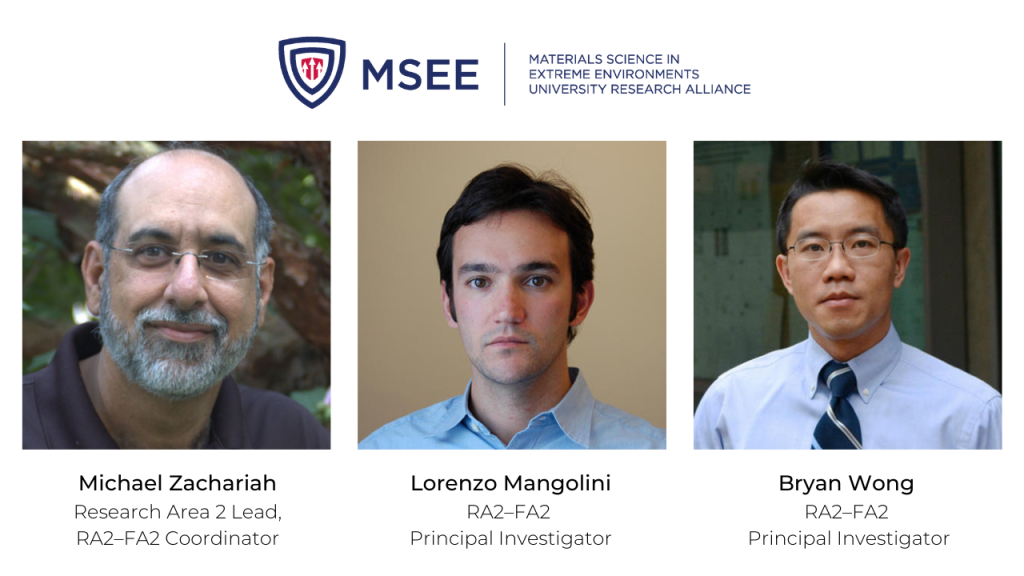The following article was originally published on 7/27/23 by the University of California, Riverside (UCR) and features Michael Zachariah, Research Area 2 Lead and RA2–FA2 Coordinator, as well as Lorenzo Mangolini and Bryan Wong, both principal investigators in RA2–FA2.
The UCR Marlan and Rosemary Bourns College of Engineering, or BCOE, has received $1 million in federal funding that will help develop science to neutralize some of the world’s greatest weapons threats. The research will help gain new perspectives on key materials’ reaction under extreme stress and lead to enhanced computer models.
Michael Zachariah, a distinguished professor of chemical engineering and materials science, leads the UCR team that helps the federal government broach that challenge. His BCOE colleagues are Lorenzo Mangolini, professor of mechanical engineering, and Bryan Wong, professor of materials science and engineering.
The UCR professors work with a three-year-old alliance of 17 universities, national laboratories, and industry partners — the Materials Science in Extreme Environments University Research Alliance, or MSEE-URA based at Johns Hopkins University in Baltimore — that supports the U.S. Defense Threat Reduction Agency, or DTRA. Their research aims to understand, predict, design, and control the reactions of materials such as concrete and solar cells in extreme conditions, as well as develop new materials to neutralize chemical and biological weapons.
Through DTRA and MSEE, UC Riverside receives a federal grant of $584,000 each year to cover supplies and graduate-student research. The $1 million grant, included by Congress in HR 2617, the 2023 omnibus spending bill, augments the standard grant.
The new money means new equipment capabilities for UCR, including a significant upgrade to a transmission electron microscope, and X-ray diffraction that will help scientists study chemical reactions under extreme conditions — including pressure, temperature, and radiation — at the nanoscale level.
“This is a big capability enhancement for UCR,” Zachariah said of the machines, which will reside in a fee-based user facility to serve the campus community.
Nanoparticle science has helped create and improve everyday goods such as batteries, LED bulbs, food packaging and flame retardants.
At BCOE, experts study nanoparticles to understand and develop materials that can target caches of chemical and biological weapons and minimize damage from nuclear blasts. For example: How can officials destroy weapons in concrete bunkers, without harming civilians?
“We give (the DTRA) the foundational science; they figure out the delivery mechanism,” Zachariah said.
Tim Weihs, director of MSEE-URA, said Zachariah and his team are key partners in developing new reactive materials for the prompt defeat of chemical agents. “UCR is an integral part of the research alliance,” he said. “(They) are providing critical insights into exciting new reactive materials and agent-material interactions. Their efforts helped the MSEE-URA gain support and recognition from Congress during the latest appropriations process.”
Looking forward, the UCR team has a bold goal: To develop simulation models to help predict and design new materials and their behavior.
“We don’t know enough yet to write good models,” Zachariah said. “So we have to do things experimentally, which is very slow.” He said the new microscope and diffractometer will expand researchers’ understanding, moving them closer to machine learning.
– Story by Gale Hammons

